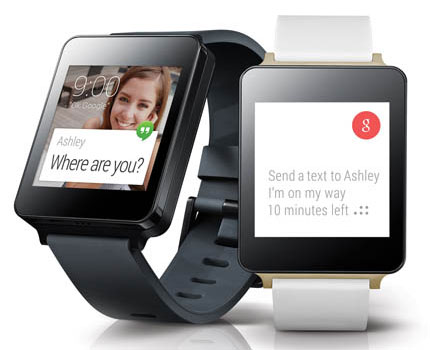LG has launched its Android Wear-powered G Watch around the world.
The smartwatch can be ordered from Google Play and purchased at retailers in the United States, Canada, France, Ireland, Germany, Italy, Spain, the United Kingdom, Australia, India, Japan and South Korea.
In 15 other countries — including Brazil, Mexico, Russia, Singapore and New Zealand — the device will be available only from retailers.
The LG G Watch is selling for US$229 in the U.S., Pounds 159 in the UK, and CA$249 in Canada. In the U.S., consumers also can order it from AT&T’s website.
Along with the Samsung Gear Live, the LG G Watch has the distinction of being an Android Wear device. Android Wear is a version of Google’s Android operating system created with smartwatches and other wearables in mind. Motorola’s Moto 360 is set to follow later this year.
Always-On Function
The LG G Watch is compatible with smartphones running Android 4.3 or higher, using the Android Wear app. The always-on model is designed to allow wearers to view notifications and other information without having to press buttons or otherwise wake the display.
There’s a degree of customization with the smartwatch, since consumers can swap out the band for any standard 22mm strap. It’s available in two colors: Black Titan and White Gold.
The LG G Watch uses a 1.2 GHz Qualcomm Snapdragon 400 processor, with 4 GB of storage and 512 MB of RAM. The LCD IPS display measures 1.65 inches and has a resolution of 280 x 280. It has 9-axis sensors, with a gyroscope, accelerometer and compass.
The dust- and water-resistant device measures 37.9 x 46.5 x 9.95mm and weighs 63 grams. It includes a 44mAh battery, which LG claims is the largest among Android Wear devices to date. It has Bluetooth 4.0 connectivity.
In terms of features, Android Wear organizes user information and attempts to present it when it’s most pertinent using Google Now, Google’s intelligent personal assistant system. For instance, it may display weather forecasts in the morning and flight information before wearers depart for the airport.
Voice Recognition
The LG G Watch also uses voice recognition to answer questions and carry out tasks, such as creating reminders or sending messages.
“Today, most wearables aren’t necessarily designed to be smartphone replacements. Instead, they’re primarily used as an extension of existing mobile technologies,” said Ryan Martin, associate analyst on the Yankee Group’s mobile and connected devices team.
“While this dynamic is likely to change in the future, LG’s G Watch — and other devices running Android Wear for that matter — is consistent with current market trends,” he told LinuxInsider.
“LG’s G Watch is an attractive option for Android users due to the wide range of smartphones with which it’s compatible,” Martin continued.
“This is particularly true when compared alongside other devices currently in the market,” he pointed out, “but this also means consumers’ focus will likely turn to the physical qualities of the device rather than the user experience — from a software/OS perspective — when evaluating purchasing decisions.”
Android Wear Advantage
Having Android Wear as the basis for the device could give the LG G Watch a leg up over the competition.
“I played with the Samsung Galaxy Gear, version one and two, and they’re good watches, but because they don’t have Android Wear, it says to me that these are devices that focus on history, and not your current context, and those same devices are lacking in that third-party application story,” Ramon Llamas, mobile phone research manager at IDC, told LinuxInsider. “Android Wear is setting itself up to do exactly just that.”
In terms of unique functionality the G Watch holds over the competition, it’s the ability to note information about its wearer that may help it stand out from the pack more than anything else.
‘Contextual Information’
“Right now, it’s really just the contextual information it can gather about the user,” Llamas suggested. “We know that’s going to be coming up later on the Samsung Gear Live watch and the Motorola device. If you look at some of the early reviews, they say ‘it’s a good watch, but you might want to wait until the next one.’ That says to me that you’re accepting this smartwatch, warts and all, and there are potentially some bugs and shortcomings that need to be hammered out in future versions and that’s OK.””
Yet the device may struggle to find a broad audience in the market because of its price point, which exceeds the upfront cost for many smartphones.
“The price point is something I’m a little wary about,” Llamas said, “mainly because how are you going to be able to explain a watch whose price point is on par with or even more expensive than the smartphone that it attaches to? In order to fully realize the strength and utility of this device, you’ve got to attach it to a smartphone. That being the case, do you want to end up paying more for this than for your smartphone? I would argue that most users probably would not.
“There really has to be something incredibly compelling about this to justify that higher price point,” he emphasized. “Could this contextualization of the user experience be part of it? Absolutely. The same thing with third-party applications, but we don’t know how robust those are just yet.”











































